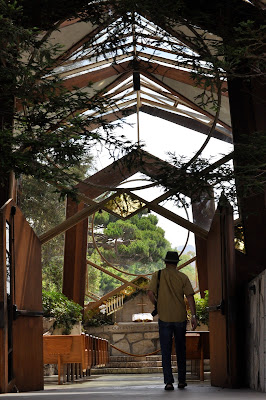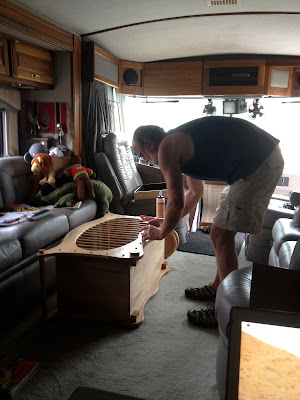Thanks to all
who’ve been emailing to congratulate us on our newest family member. The past couple of weeks have been quite
the family extravaganza. Over the past two weekends Grandparents Deb and Bill came in from
Las Vegas, Tante Tash flew in from Pennsylvania, and Grandparents Wayne and Betsy arrived
from New Hampshire. Jess and Pete
were very tolerant of all the family members flocking in to pay homage
to Nora - despite being tired and still a little overwhelmed with the new
addition to their home. On the
other hand, Nora was quite the little lady, saving her fussy moments for Mom
and Dad – how considerate!
Of course, there
was never a moment when a camera wasn’t out with shutters snapping - usually
mine!
The star of the show, Nora Mae.
The new family, Pete, Jess, and Nora.
Grandma (Deb) getting in some cuddle time.
Grandpa (Bill) holding precious cargo.
Tante Tash and Nora meet for the first time.
Naptime for Opa (Heinz) and Nora.
Nana (Betsy) checking for dimples.
Pure joy from Poppi (Wayne) over his first granddaughter.
And of course, Oma (me) got her turn snuggling in with the star.
Everyone debating politics... or the Nora cuddling schedule!
When we weren’t
busy cooing and making silly faces at Nora, Heinz and I managed to fill our
time.
One day we drove
over to Rancho Palos Verdes to see the Wayfarers Chapel. The church, built in 1951, is on the
National Registry of Historic Places.
It is sponsored by the Swedenborgian Church
and is made almost entirely of glass.
Lloyd Wright
(son of Frank Lloyd Wright) designed the chapel and surrounding gardens. He used only 30 and 60-degree angles
because they occur naturally in snowflakes, crystals, and tree branches. Redwood pillars rise from interior
stone planters like giant tree trunks.
The plants in the planters were chosen because they are found on the
forest floor and are intended to make the exterior and interior spaces
one. The trees on both sides of
the exterior of the chapel are coastal redwoods. The stone capping the altar is a variety of Palos Verdes
stone called moss back.
The Wayfarers Chapel
Indoor columns of redwood with interior plantings.
Coastal redwoods line the outside of the chapel.
It was a little
weird to see the following sign on the way to the chapel. Seems the local area is not the most
stable ground in California.
Gosh, can't wait to travel this section of the highway!
On another day
we checked out the Tattoo Expo at the Fairplex
in Pomona - our first ever tattoo event. No, we
did not get one, but we did see some really bad
tattoos, as in, “What in the world were you thinking when you got that?”, bad. But there were also some really terrific tattoos walking around. It’s not really our thing, but we could
appreciate the art.
Adding more tropical flowers.
Patience and a tolerance for pain are virtues in this type of art.
On the way into
the Expo we spotted an outdoor model train display, so of course we had to stop
in and see what it was all about.
Turns out that the Fairplex Garden Railroad
is considered the oldest miniature railroad in the U.S. It began in 1924 as a static display
for the Los Angeles Fair. By 1935
it had morphed into a hand-built operating train in 1/2- inch scale and had
moved into its current 100 x 300 foot outdoor location. In 1997 members of local miniature
railroad clubs replaced the original display with G-gauge model railroads and
trains. There are over 9,800 feet
of track, and up to 30 trains can run at one time. According to the website, there are approximately 2,000
linear feet of underground pipes and conduits to support the operation and
nearly 18 miles of electrical wiring.
The theme of the
display is the history of California and the role of the railroads. The exhibit depicts scenes of mining,
logging, mission life, business and residential development, industrial areas,
and oil drilling. The railroad
runs through mountains, farmlands, lakes, rivers, towns, and deserts. There is a working switchyard to move
cars and engines between trains, load and unload cargo, and all the other
activities of a railroad yard.
If you love
model railroads here’s a link to a great view of this one from the viewpoint of
the engine: www.youtube.com/watch?v=XSKxp9PhTWY
Old West town along the railroad.
A vintage train moving on down the tracks.
A more modern train heading west.
Heinz checking out the switchyard.
We are always
looking out for the fun and unusual, but never expected to find it while
hitting a drive-through for breakfast.
Check the fancy wheels on the vehicle in line ahead of us. Turns out that just down the road from
the Navy Base (where we were staying) was Leisure World - a retirement community. Apparently the smell from the fast food restaurant is too much at times, and appetites MUST be quenched.
Styling through the Carl's Jr. drive-through - yes, there is even a dog on her lap.
We took two
drives along Mulholland Drive, one by motorcycle
and one by car. We've heard a lot of oohs
and aahs over the years about this drive - but we found it to be a bit of a let down. The road travels through the Santa
Monica Mountains and is featured in movies, songs, and novels. It opened in 1924, built by developers
investing in the Hollywood Hills residential site. The road is 22 miles long, mostly two-lane, and connects two
sections of U.S. Route 101.
Our first drive
was by motorcycle along the Mulholland Highway portion, and Heinz and I had
to stop at the Rock Store. This is one of the most famous biker
hangouts in the world - located halfway between Malibu and Calabasas. The building is made of volcanic rock
and was built as a stagecoach stop circa 1910. In 1961 Ed and Vern Savko bought the building and turned it
into a small grocery. Over the
years the motorcycling community discovered it as a genial place to stop while
riding the winding road and the Savko’s eventually closed the grocery and
turned the building into a small café and bar.
The Rock Store
Our second drive was by car along the Mulholland Drive portion, between the Hollywood Bowl and I-405. The route does
offer spectacular views of the Los Angeles Basin, the San Fernando Valley, and
the Hollywood sign, but you have to stop at the various vista points to see
these views. While it is home to
some of the most exclusive and expensive homes in the world, they are set
back from the road and seldom seen.
Overall, the
general opinion of Heinz, Tash, and me was “ok, been there, done that, it’s a
non-event,” although Pete and Jess assured us that it is much more spectacular
in the winter when the smog has blown out and the foliage is greener.
Hollywood sign from a Mulholland Drive
overlook. The sign originally read
Hollywoodland and was created as an advertisement for local real estate
development in 1923. It was preserved after the movie industry made it big in Los Angeles.
Los Angeles Valley from Mulholland Drive.
Tash and Heinz picking out familiar landmarks from a Hollywood Bowl overlook.
Of course, I had to make a pilgrimage the Long Beach Farmers Market and went just a little bit crazy with all the
fresh fruits and vegetables picking up fresh nectarines, asparagus, local
wildflower honey, potatoes, and on and on. And then I saw them…Maui onions…absolutely HAD to buy a
couple.
Maui onions with a large yellow onion in the middle. So what do you do with a 4 lb. onion?
Caramelize it and make an onion tart of course. There was enough in one Maui onion to make a tart, an omelet, and still have half left over to tuck into the freezer for another day.
Our last
expedition was down to Olvera Street. This is the original old town of Los
Angeles. The area was designated a
California State Historic Landmark in 1953. It is a quaint and colorful area and celebrates the Mexican
culture of Los Angeles’ past.
There are over 80 shops, vendor stalls, and restaurants along this 4-block
street. Tash, Heinz, and I stopped
in at La Golondrina Mexican Café for tasty food and nice margaritas, followed
by some strolling and shopping among the shops and vendors.
Tash and her pomegranate margarita.
Colorful vendors along Olvera Street.
Lucha libre (Mexican wrestling) masks for sale.
Shop on ladies, I'll wait here in the plaza.
We’ve torn ourselves
away from Nora and moved on to Edwards AFB again, for a few days of routine maintenance on the vehicles.
Heinz is also washing all the ocean salt off the rig, the car, and the
motorcycle. It’s hot here, but
we missed the 105+ temperatures - it’s just in the high 90’s instead. No problem, the air conditioners are
working like a dream.
I’ll leave you
with more photos of that amazing new grand-daughter instead of our usual
friends of the day…
Hey, hey, HEY, that’s mine, give it back!
Uh Heinz... it's Betsy's turn to hold the baby. Baby? What baby? I don't have the baby!
Humph! So this is what all the fuss has been about. It can't even bark for heaven's sake!
Oh No! I just know you're gonna pull this picture out when my first date arrives to pick me up!!
Is she in there? What’s she doing?
Whoa, you people are wearing me out! Good Night!


















































































